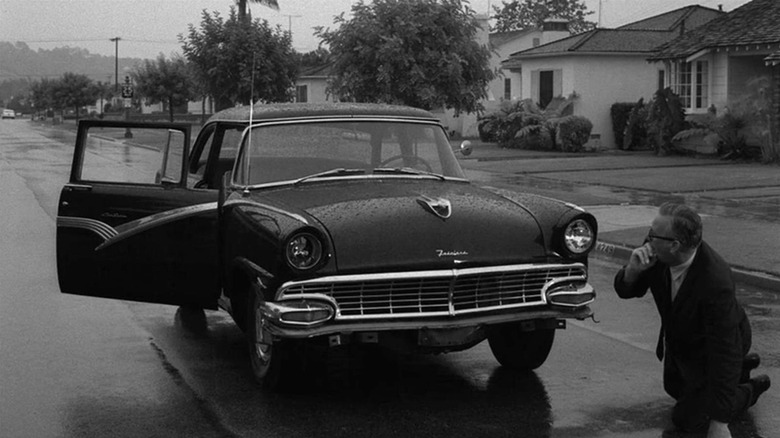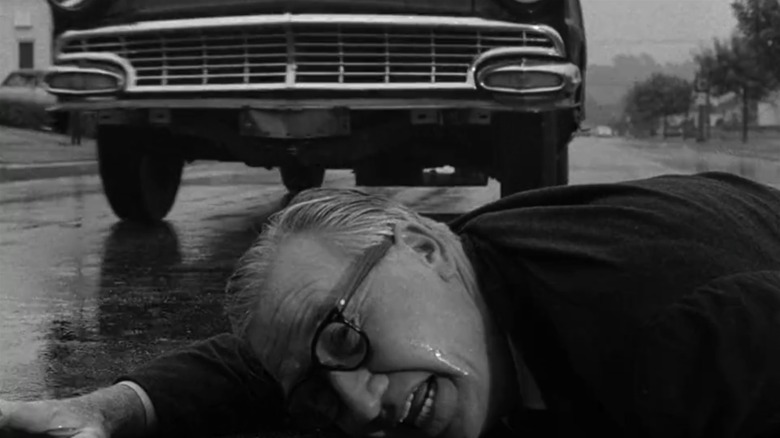How The Twilight Zone Used '60s Movie Magic To Create A Self-Driving Car
Rod Serling's "The Twilight Zone" features several stories about haunted towns, extraterrestrial invasions, and every strange thing that occurs within the titular liminal space, where belief and superstition meet. (Remember when an entire town of actors was seemingly frozen in place?) In the show's 134th episode, "You Drive," a sentient car hounds a guilty man to mete out justice — in this instance, technology and human inventions are not symbols of doom, but demonstrate self-awareness and morals that some of their inventors or users lack. Although the writing in this episode comes off as muddled or shallow at times, "You Drive" remains memorable for pulling off an impressive feat: Creating the illusion of a self-driving car following a guilty man around.
Before we delve into the mechanics of the sequence, here's a recap the broad strokes of the story. Oliver Pope (Edward Andrews), an anxious, self-absorbed government official driving a 1956 Ford Fairlane Club Sedan, accidentally slams into a child riding a bicycle. As the boy lies on the road, grievously injured, Oliver chooses to run, displaying no empathy for the boy or guilt for the accident. Even after a coworker is wrongfully accused of the crime, he does not step forward, clinging to his crumbling moral compass while getting more irritable over time.
By then, the sentient car, his own Ford Sedan, decides enough is enough. The vehicle rebels against Oliver by trying to awaken his conscience, but after these benign efforts fail, it aggressively starts pursuing him. (Sounds a little like a precursor to Stephen King's car-centric story "Christine," which, last we heard, is getting a remake from writer/director Bryan Fuller.) Oliver falls and the car door opens, and the vehicle drives him to the police after he gets in, and the perpetrator is compelled to confess. It's a simple morality tale that inverts the burden of conscience between man and machine and examines the inner minds of people who are deliberately passive about their wrongdoings.
A tiny periscope and some reverse-driving magic
According to Marc Scott Zicree's "The Twilight Zone Companion," television writer and "The Twilight Zone" producer William Froug explained how the self-driving car sequences were achieved:
"We had a man under the dashboard with a tiny periscope that stuck up through the hood of the car, and he drove with special controls. I remember watching it, because I was on location when it was filmed, and I was astonished. This car would come driving by and it was spooky because you couldn't see this little periscope sticking up."
This is a rather clever way of creating an illusion of a sentient automobile, but how did the Ford Sedan roar to life while inching towards Oliver lying on the street only to screech to a perfect halt near his head? To make it seem as if the car made a last-minute decision to spare Oliver's life and grant him a fair chance to own up to his crime, the sequence was shot in reverse, where the car was started right in front of the actor's head and then pulled back. Pulling this off effectively requires remarkable skill, given how the vehicle appears to speed up and slow down as if possessing a will of its own, where it almost runs over its owner.
Serling ends the episode with a somber closing narration, stating that every individual who conceals their hit-and-runs should be "hereby warned," and check their vehicles, lest they conceal a conscience. In actuality, it's an appeal to look within and dig up a conscience when it is needed the most.
For more about "The Twilight Zone," check out our list of the seven most notable episodes, ranked.

